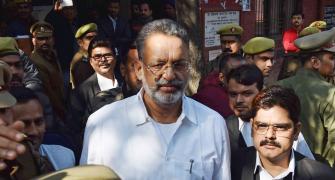Colonel Anil Athale (retd), the official historian of India's 1962 war with China, pin-points the reasons for the clash between the Asian giants 50 years ago and the series of blunders that led to India's military humiliation.
October 12, 1962, on his way from Madras (now Chennai) on a visit to Sri Lanka, India's then prime minister Jawaharlal Nehru, when harried by reporters about the clashes on the China border, remarked that his government had directed the Indian Army 'to free our territory in the northeast frontier', implying, incorrectly, that India had decided to engage China in a full-scale war.
On October 14, China's People's Daily quoted Nehru and told its readers to expect an invasion of China by India. One author would later write 'Nehru's casual statement only served to precipitate the Chinese attack on India.' Many in India have swallowed this canard.
While speaking to this author in May 2003, Professor J K Galbriath, the influential American ambassador to India at that time, believed that the 1962 Sino-Indian conflict was 'accidental', a sort of escalation that neither side wanted. On the other hand there is clear evidence that the Chinese were well prepared for an armed conflict.
An in- depth analysis of those events is of more than academic interest in the 21st century as India and China rise on the world stage, there is a possibility of clash between the two Asian giants.
Indians lack a sense of history as we tend to think in Yuga or thousand-year cycles, in re-birth and have a taboo about writing or saying anything against a dead person. History if seen as a search for the truth, then in India it is also the first causality of this mindset.
The 1962 clash of arms between India and China was insignificant in terms of troops involved (just three divisions on our side and about six from the Chinese side). The conflict took place in remote, sparsely populated area and lasted only about a month, from October 20 to November 21, 1962. But in terms of its impact on Nehru and India, it was indeed a major event.
Even 50 years after the event the dispute remains unsolved.
At a personal level, it shattered Nehru and India lost self confidence. A nation that was till then being compared with China and was regarded as its competitor in Asia, began to be equated with puny Pakistan.
During the conflict itself, Nehru, the true democrat that he was, bowed to Opposition pressure and ordered an inquiry into the 1962 debacle. The two-member committee consisted of Lieutenant General Henderson Brooks and Major General Prem Singh Bhagat, Victoria Cross.
The report continues to be kept out side public domain till date though the official history, largely based on this report, is now freely available on the Internet.
The initial expectation was that the inquiry would be a comprehensive one and would go into the policy issues and higher direction of war. But Nehru would have none of it and the work of Henderson Brooks and Bhagat was confined to the military aspects of the debacle. In this they did a through job indeed. Bhagat, an old hand at the Military Operations directorate was alert and had all the rooms containing the official files sealed before interested parties could tamper with the records.
The report was in my personal custody for over two years (1987 to 1988) and used fully to write the official history of that conflict. There is very little to add to that and one must keep that issue aside.
Wars are fought for political objectives and foreign policies and calculations of national interest play a major role in decision making. No war history can be complete without assessment of these aspects.
Here unfortunately the war history division met with a solid wall of resistance from the ministry of external affairs. The ministry put such impossible conditions that our director Dr Prasad, gave up any further attempts to access the records.
The MEA insisted that the records can only be seen in their office. All the notes made would be left there and scrutinised by the ministry. Luckily, that did not prove too much of a handicap since the ministry of defence had kept meticulous records of the joint meetings held with the secretary general of the MEA and one can have glimpse of the process of policy making.
The fateful decision
Tensions had been rising on the Ladakh front since 1959 when India discovered that the Chinese had built a highway connecting Tibet with Sinkiang through the Indian territory of Aksai Chin.
To counter this Nehru in consultation with Lieutenant General B M Kaul (of the supply corps and his cousin) embarked upon a 'forward policy' of establishing small posts with 5 to 10 men in the areas claimed by the Chinese as theirs. These posts were militarily and logistically unviable and showed Nehru's legalistic bent of mind.
When this led to several armed clashes between the two sides, the military command carried out a major brainstorming exercise, code named 'Sheel' on October 15, 16, 1960 (a full two years before the actual Chinese attack). The professional assessment of the military was that a minimum of seven battalions would be needed and if these are to be withdrawn from the Pakistani border then additional troops would have to be raised.
The government brushed aside the army's apprehensions, turned down the request to raise additional battalions and ordered the army to establish posts as ordered.
As the situation on the border began to worsen, the Western Command wrote to the headquarters on August 15, 1962 that in view of the Chinese military superiority on the border, war must be avoided at all costs.
But less than a month before the attack, army headquarters replied that the 'forward policy' is a success as borne out by the facts as Chinese exercised restraint.
'We must show our flag' was the order.
As Nehru faced a hostile Opposition and wanted the army to 'do something', General Kaul, an ambitious general who even figured as a possible successor to Nehru, proposed a bizarre idea of offensive action in the eastern sector, nearly 1,000 kilometres away from Ladakh. The situation there was even worse than in Ladakh in terms of logistics.
Thus, it is India that activated the eastern sector. The army headquarters had no idea of the situation on ground.
Lieutenant Colonel Eric Vas (later a lieutenant general) who led the first battalion that was inducted in Tawang tried to highlight the problems by dramatically writing a letter on a Chapati as there were shortages of everything from ammunition to clothing and even stationary! But Vas was sacked from his command.
It was only in the last week of September that the nation woke up to the reality when the Chinese mauled an Indian patrol in this sector.
But despite all this in a classic example of those chaotic times, on September 22, 1962, a joint secretary in the ministry of defence H C Sarin issued the war directive. It is an unworthy example of how not to go to war and therefore deserves to be quoted in full.
'The decision throughout has been as discussed earlier that the army should prepare and throw out the Chinese as soon as possible. COAS was accordingly directed to take action accordingly for eviction of the Chinese from Kameng frontier division as soon as he is ready./
The 1962 border conflict had another dimension to it -- the struggle between Nehru's policy of non-alignment and a determined group that wanted India to join the Western camp led by the US.
In early 1962 during the elections for the third Lok Sabha, the attention of the whole country was riveted on the electoral clash between V K Krishna Menon of the Congress and J B Kriplani of the combined Opposition. Nehru saw this as a direct challenge to his foreign policy.
Thanks to the December 1961 annexation of Goa, Menon as defence minister took full credit and defeated Kriplani by over 100,000 votes. Kriplani's criticism of Nehru's China policy failed to make any dent.
The electoral defeat seems to have not dampened the enthusiasm of the pro-West lobby. There is enough evidence to show that B N Mullick, the powerful chief of the Intelligence Bureau, was very aggressive and did everything in his power to provoke the Chinese.
Even Nehru's casual remark while going on a visit to Sri Lanka was headlined by the Indian Express as a policy statement. Its editor Frank Moraes was a known critic of Nehru's policy of keeping distance from the West.
While the Henderson Brooks report dealt mainly with the military aspect of the conflict, there is indeed a hint that a group of individuals within the Government of India was determined to provoke a military confrontation with China.
Most of the blame for the military debacle has been laid at the doorstep of Nehru and Menon. Nehru indeed must take the blame for the systematic neglect of defence preparedness in terms of equipping the armed forces for a conflict in Himalayas.
The casualties of the conflict of around 4,000, a full half were due to the weather. The Indian soldiers were equipped with Lee-Enfield bolt action rifle of 1900s vintage. In the cold of Ladakh, where the temperatures reach minus 40 degrees centigrade, the soldiers were forced to operate the metal bolts with bare hands!
Over 2,000 soldiers suffered chilblains and cold injuries resulting in amputation of hands! The bureaucracy even denied authorising emergency rations of chocolates -- then a monopoly of the elite!
But in fairness, Nehru was not blind to the Chinese threat. Where he went wrong was not factoring in the effect of the Cuban missile crisis, that shut out the implicit American aid to India at a crucial moment. Thomas C Schelling in his seminal work Arms and Influence (Yale University Press, 1966, page 53) says that while help to India against China was not a 'policy', it was nevertheless an implicit commitment. He further remarks that Nehru anticipated it for over ten years.
The Cuban missile crisis that took place concurrently however put paid to these Indian expectations. There is enough evidence to show that the Chinese exploited the crisis to 'straighten out' the border with India.
However, it must be clearly mentioned that while some of the Indian actions were provocative, the Chinese had prepared in advance for the military clash. Some Westerners notably Neville Maxwell, (author of the widely quoted India's China War) have tried to blame India for the war, claiming that the Chinese actions were a 'reaction' to Indian provocations. This is military nonsense.
Tibet at that time had very tenuous communications with mainland China. The support bases for the Chinese army were nearly 2,000 km away from the battlefield. Everything from a needle to food had to be stocked over period of six months.
The Chinese preparations to attack India were going on for at least six months prior to the shooting war. The Chinese had in place heavy artillery in Ladakh that had been shifted from the Formosa front.
All this puts paid to the canard that China merely 'reacted' to the Indian provocations! Maxwell is a confirmed Maoist and his account while seemingly accurate, leaves out the crucial issue of Chinese premeditation and preparation.
A brief summary of the events of those early days of 1962 conflict would clarify the issue:
In 1959, China intruded into the unmanned Aksai Chin area and constructed a road linking the restive province of Sinkiang with Tibet. It was a militarily important road for China.
India had meagre strength in Ladakh and the troops were entirely dependent on air supply, the road link to Leh was barely operational. India neither had the troops or logistics to undertake operations to evict the Chinese from Aksai Chin.
China showed no desire to acquire any more areas, but the Indian government under pressure of public opinion decided to 'do something' about the occupation. Military professional advice asked the government to first build infrastructure and stall the Chinese in the meantime.
'Do something' was translated into a 'forward policy' whereby militarily unsound small posts were established in the disputed Aksai Chin areas. As China became uneasy with these posts and threatened to use force, a new front was opened in the North-East Frontier Agency (now Arunachal Pradesh) on the advice of the military who claimed that India was stronger there and could create 'diversion' to reduce the threat to Ladakh.
The Chinese were aware of the impending Cuban missile deployment and calculated that the US would be engaged in a major confrontation with the erstwhile USSR to come to India's aid. The Chinese methodically built up its supplies and troops in Tibet to wait for the onset of the Cuban missile crisis.
That opportunity came on October 20 when the US decided to confront the USSR on Cuba.
Colonel Anil Athale (retd), as joint director of the War History Division, Ministry of Defence, researched and co-authored the official history of the 1962 India-China war.
Also read:
Remembering a War





